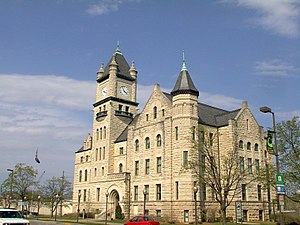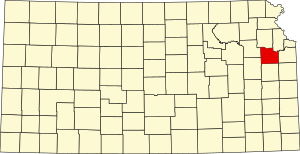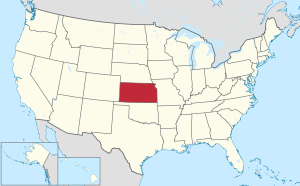Douglas County, Kansas
Douglas County is a county in the U.S. state of Kansas. In 2020 census, there were 118,785 people living in the county.[1] That made it the fifth-most populous county in Kansas. The city with the most people is Lawrence.[2]
Douglas County | |
|---|---|
 Douglas County Courthouse in Lawrence | |
 Location within the U.S. state of Kansas | |
 Kansas's location within the U.S. | |
| Coordinates: 38°52′N 95°14′W / 38.867°N 95.233°W | |
| Country | |
| State | |
| Founded | August 25, 1855 |
| Named for | Stephen Douglas |
| Seat | Lawrence |
| Largest city | Lawrence |
| Area | |
| • Total | 475 sq mi (1,230 km2) |
| • Land | 456 sq mi (1,180 km2) |
| • Water | 19 sq mi (50 km2) 4.0% |
| Population | |
| • Total | 118,785 |
| • Density | 260.5/sq mi (100.6/km2) |
| Time zone | UTC−6 (Central) |
| • Summer (DST) | UTC−5 (CDT) |
| Area code | 785 |
| Congressional districts | 1st, 2nd |
| Website | douglascountyks.org |
History
changeEarly history
changeFor many centuries, the Great Plains of North America was inhabited by nomadic Plains Indians. From the 16th century to 18th century, the Kingdom of France claimed ownership of large parts of North America. In 1762, after the French and Indian War, France secretly gave all the territory west of the Mississippi River to Spain, per the Treaty of Fontainebleau.[3]
19th century
changeIn 1802, Spain returned most of the land to France. But, it kept about 7,500 square miles. In 1803, most of the land including the modern-day state of Kansas was acquired by the United States from France as part of Louisiana Purchase.
In 1854, the Kansas–Nebraska Act created the territory of Kansas. In 1855, Douglas County was established. Douglas County was opened for settlement on May 15, 1854. It was named for Stephen A. Douglas.[4] The county was practically at the center of the Bleeding Kansas years as leaders in Lecompton, the territorial capital, wanted Kansas to be a slave state. Leaders in Lawrence wanted Kansas to be a free state. A number of events took place in Douglas County. These including the drafting of the controversial Lecompton Constitution (trying to admit Kansas as a slave state),[5] the sacking of Lawrence,[6] and the Battle of Black Jack.[7]
The first railroad in Douglas County, the Union Pacific, was built through that territory in 1864.[8]
Geography
changeThe U.S. Census Bureau says that the county has a total area of 475 square miles (1,230 km2). Of this, 456 square miles (1,180 km2) is land and 19 square miles (49 km2) (4.0%) is water.[9] It is the fifth-smallest county in Kansas by land area. Much of its northern border is defined by the Kansas River, which goes through Lawrence. The Bowersock Dam is one of the county's producers of hydropower.[10]
Lakes
changePeople
change| Historical population | |||
|---|---|---|---|
| Census | Pop. | %± | |
| 1860 | 8,637 | — | |
| 1870 | 20,592 | 138.4% | |
| 1880 | 21,700 | 5.4% | |
| 1890 | 23,961 | 10.4% | |
| 1900 | 25,096 | 4.7% | |
| 1910 | 24,724 | −1.5% | |
| 1920 | 23,998 | −2.9% | |
| 1930 | 25,143 | 4.8% | |
| 1940 | 25,171 | 0.1% | |
| 1950 | 34,086 | 35.4% | |
| 1960 | 43,720 | 28.3% | |
| 1970 | 57,932 | 32.5% | |
| 1980 | 67,640 | 16.8% | |
| 1990 | 81,798 | 20.9% | |
| 2000 | 99,962 | 22.2% | |
| 2010 | 110,826 | 10.9% | |
| 2020 | 118,785 | 7.2% | |
| U.S. Decennial Census[11] 1790–1960[12] 1900–1990[13] 1990–2000[14] 2010–2020[1] | |||
Douglas County includes the Lawrence, Kansas United States metropolitan area.
In 2020, there were 118,785 people living in Douglas County. The people were 78.0% White, 4.5% Black or African American, 2.5% Native American, 3.9% Asian, 0.1% Pacific Islander, 2.2% from other races, and 8.8% from two or more races. 7.0% of the people were Hispanic or Latino.
There were 48,553 households. 25.2% of them had children under 18 years old; 39.8% of them had married people; 28.7% had only a woman as the main person (with no man); 33.1% were people living alone; and 9.6% were people over 65 years old living alone.
18.9% of the people were under 18 years old; 20.3% of the people were between 18 and 24 years old; 26.8% of the people were between 25 and 44 years old; 20.2% of the people were between 45 and 64 years old; 13.8% were 65 years old or older.[15]
Government
changeCounty
changeThe Democratic Party has been dominant in Douglas County. Democrats control all County-wide offices in the county. Douglas County is currently served by county commissioners Patrick Kelly, Shannon Reid, and Karen Willey.[16][needs update] All are Democrats.
State
changeAs of 2024[update], Democratic state representatives representing portions of the county include Christina Haswood (10th District), Barbara Ballard (44th District), Mike Amyx (45th District), and Dennis Highberger (46th District); Republican state representatives include Carrie Barth (5th district), Lance W. Neelly (42nd District), William Sutton (43rd District), Ronald Ellis (47th District), and Adam Turk (117th District).[17] Two Democratic state senators, Marci Francisco (2nd District) and Tom Holland (3rd District), and one Republican state senator, Rick Kloos (19th District), represent portions of the county.[18]
Presidential elections
change| Year | Republican | Democratic | Third Parties |
|---|---|---|---|
| 2020 | 28.8% 17,286 | 68.0% 40,785 | 3.1% 1,870 |
| 2016 | 28.8% 14,688 | 61.1% 31,195 | 10.1% 5,148 |
| 2012 | 35.9% 17,401 | 60.4% 29,267 | 3.7% 1,796 |
| 2008 | 33.4% 17,929 | 64.1% 34,398 | 2.5% 1,314 |
| 2004 | 41.0% 20,544 | 57.1% 28,634 | 1.9% 933 |
| 2000 | 42.8% 17,062 | 45.8% 18,249 | 11.4% 4,527 |
| 1996 | 42.6% 16,116 | 47.9% 18,116 | 9.4% 3,568 |
| 1992 | 30.6% 12,949 | 46.0% 19,439 | 23.4% 9,877 |
| 1988 | 49.9% 16,149 | 48.7% 15,752 | 1.4% 460 |
| 1984 | 58.9% 18,975 | 40.0% 12,880 | 1.2% 378 |
| 1980 | 49.0% 14,106 | 32.5% 9,360 | 18.5% 5,318 |
| 1976 | 51.3% 14,277 | 42.8% 11,922 | 5.9% 1,643 |
| 1972 | 55.6% 15,316 | 42.3% 11,646 | 2.1% 565 |
| 1968 | 53.8% 10,533 | 35.4% 6,936 | 10.8% 2,114 |
| 1964 | 45.1% 7,825 | 54.3% 9,416 | 0.7% 112 |
| 1960 | 66.4% 11,337 | 33.3% 5,690 | 0.2% 38 |
| 1956 | 71.9% 11,029 | 27.9% 4,283 | 0.3% 39 |
| 1952 | 74.3% 11,095 | 25.2% 3,765 | 0.4% 64 |
| 1948 | 64.3% 9,287 | 33.1% 4,778 | 2.7% 389 |
| 1944 | 67.5% 8,224 | 31.9% 3,886 | 0.7% 79 |
| 1940 | 70.3% 9,146 | 28.6% 3,727 | 1.1% 141 |
| 1936 | 62.2% 8,324 | 37.1% 4,961 | 0.7% 96 |
| 1932 | 58.7% 7,346 | 38.6% 4,833 | 2.7% 342 |
| 1928 | 78.7% 8,887 | 20.3% 2,297 | 1.0% 108 |
| 1924 | 75.3% 8,052 | 18.0% 1,922 | 6.8% 726 |
| 1920 | 73.2% 6,266 | 25.7% 2,197 | 1.1% 94 |
| 1916 | 53.9% 4,975 | 41.5% 3,834 | 4.6% 426 |
| 1912 | 21.8% 1,133 | 36.3% 1,888 | 41.9% 2,182 |
| 1908 | 60.6% 3,279 | 37.2% 2,010 | 2.2% 119 |
| 1904 | 74.3% 3,574 | 20.6% 989 | 5.2% 249 |
| 1900 | 58.6% 3,453 | 39.6% 2,333 | 1.9% 111 |
| 1896 | 57.4% 3,582 | 41.2% 2,573 | 1.4% 85 |
| 1892 | 57.3% 3,114 | 42.7% 2,320 | |
| 1888 | 60.0% 3,189 | 31.4% 1,669 | 8.6% 455 |
Douglas County has a political history similar to that of the Yankee Northeast than of the Great Plains. This can be seen from its voting history. It has the exact same voting history as that of Vermont or Cheshire County, New Hampshire (except the 1912 presidential election). This is due to the county's strong New England heritage. Douglas County voted for the Republican candidate in every Presidential election between 1864 and 1960, except in 1912 when it voted for Progressive Theodore Roosevelt. The Republican presidential nominee got over sixty percent of Douglas County's vote in every election between 1920 and 1960 (except 1932 when Herbert Hoover received 58.7 percent). To show how deeply the county's Republican roots ran, even when Kansas voted for Franklin D. Roosevelt in 1932 and 1936, Republican candidates won the county easily.
This changed in 1964, with the anti-Yankee feeling and Southern leanings of Barry Goldwater. This led to Douglas County voting for Lyndon B. Johnson, making Johnson the first Democrat ever to win the county. With more moderate GOP candidates, the GOP carried the county in every election between 1968 and 1988. However, the growing transformation of Lawrence into a liberal academic town pulled the county into the Democratic column from 1992 onwards. This was similar to many counties around the United States with college towns. Since the 2004 election, Douglas County has been one of the strongest Democratic places in Kansas, second only to Wyandotte County. Often, Douglas and Wyandotte are the only two counties in the state to vote for Democratic presidential candidates.
Education
changeUnified school districts
changeDouglas County is served by seven school districts.
- Lawrence USD 497 serves Lawrence and the Clinton Lake area.
- Baldwin City USD 348 serves Baldwin City and most of southern Douglas County.
- Perry-Lecompton USD 343 serves Lecompton and most of northwest Douglas County.
- Eudora USD 491 serves Eudora and the northeast part of the county.
- Santa Fe Trail USD 434 covers the southwest part of the county.
- Wellsville USD 289 covers extreme southeast Douglas County.
- "Shawnee Heights USD 450". Archived from the original on 2008-04-30. services the far western part of the county including Big Springs.
Universities and colleges
changeThe University of Kansas's main campus is in Lawrence. Haskell Indian Nations University is also in Lawrence. Baker University, the state's oldest university, is in Baldwin City, Kansas.
Parks
changeClinton Lake, completed in 1980, offers boating, fishing and other water sports. Various parks around the lake have camping and trails for mountain biking, hiking and horseback riding.[20]
Lone Star Lake is a small lake to the southwest of Lawrence. It offers fishing, boating and camping. Just northwest of Baldwin City is Douglas State Fishing Lake which provides hunting, fishing and limited camping. Other parks around the county include Black Jack Park, which includes the Ivan Boyd Prairie Preserve and Robert Hall Pearson Memorial Park, Broken Arrow Park in Lawrence, and Wells Overlook Park just south of Lawrence.[21]
Events
changeBig events in the county include the Maple Leaf Festival in Baldwin City every third full weekend in October.[22] Lecompton's Territorial Days take place every year in June.[23] Lawrence has many parades throughout the year including Christmas and St. Patrick's Day.[24][25]
Transportation
changeMajor highways
change- I-70 / Kansas Turnpike, runs east to west just north of Lawrence.
- US-59 runs north to south through the middle of the county and the middle of Lawrence.
- US-40 virtually follows the Oregon Trail heading west out of Lawrence.
- US-56 runs east to west in the southern half of the county, going through Baldwin City and skirts the Santa Fe Trail.
- K-10 runs from the I-70 Lecompton Exchange along the south and west border of Lawrence to US-59 then north until 23rd Street where it heads east out of town into Johnson County.
Other major highways include:
- US-24 which is in Grant township leading from Leavenworth to Jefferson County.
- K-32 starts just outside Lawrence and leads into Leavenworth County.
- K-33 is in extreme southeast Douglas County and leads into Franklin County.
County Highways
changeDouglas County also maintains an extensive network of county highways to serve the rural areas of the county. None of these county highways go into Lawrence.
Communities
changeIncorporated cities
changeUnincorporated communities
changeRelated pages
change- Kansas River – Natural crossing point for westward wagon trains on the Oregon Trail
- California Road – Cutoff on the Oregon Trail to Lawrence, Kansas from Westport
- Santa Fe Trail Swales – Visible near "Black Jack Park". Archived from the original on 2003-06-05.
- "Geographic Information System Viewers". Archived from the original on 2008-09-27.
References
change- ↑ 1.0 1.1 1.2 "QuickFacts: Douglas County, Kansas". United States Census Bureau. Retrieved September 27, 2023.
- ↑ "Find a County". National Association of Counties. Retrieved 24 June 2016.
- ↑ "Paris, Treaty of (1763)". U.S. History in Context. Gale, Cengage Learning. Retrieved 24 June 2016.
- ↑ Henry Gannett (1905). The Origin of Certain Place Names in the United States. Govt. Print. Off. p. 108.
- ↑ "Discover Lecompton, KS". Douglas County Senior Services. Archived from the original on 12 August 2016. Retrieved 24 June 2016.
- ↑ "The Sack of Lawrence, Kansas, 1856". Eye Witness to History. Retrieved 24 June 2016.
- ↑ "Black Jack Battleground in Douglas County, Kansas". Civil War on the Western Border. Retrieved 24 June 2016.
- ↑ Frank Wilson Blackmar (1912). Kansas: A Cyclopedia of State History, Embracing Events, Institutions, Industries, Counties, Cities, Towns, Prominent Persons, Etc. Standard Publishing Company. p. 539. ISBN 9780722249055.
- ↑ "US Gazetteer files: 2010, 2000, and 1990". United States Census Bureau. 2011-02-12. Retrieved 24 June 2016.
- ↑ "Bowersock Mills & Power Company". Kansas Travel, Tourism & Restaurants. Retrieved 24 June 2016.
- ↑ "U.S. Decennial Census". United States Census Bureau. Archived from the original on May 12, 2015. Retrieved July 24, 2014.
- ↑ "Historical Census Browser". University of Virginia Library. Archived from the original on August 11, 2012. Retrieved July 24, 2014.
- ↑ "Population of Counties by Decennial Census: 1900 to 1990". United States Census Bureau. Retrieved July 24, 2014.
- ↑ "Census 2000 PHC-T-4. Ranking Tables for Counties: 1990 and 2000" (PDF). United States Census Bureau. Retrieved July 24, 2014.
- ↑ "DP1: PROFILE OF GENERAL POPULATION AND HOUSING CHARACTERISTICS". United States Census Bureau. Retrieved September 27, 2023.
- ↑ "County Commission". Douglas County, Kansas. Retrieved May 6, 2024.
- ↑ "Kansas State Representatives" (PDF). Douglas County, Kansas. Retrieved May 6, 2024.
- ↑ "Kansas State Senators" (PDF). Douglas County, Kansas. Retrieved May 6, 2024.
- ↑ "Dave Leip's Atlas of U.S. Presidential Elections".
- ↑ "Clinton Lake". Archived from the original on 2012-02-15. Retrieved 2012-02-11.
- ↑ http://douglas-county.org/depts/pw/pw_countyparks.aspx?category_id=[permanent dead link]
- ↑ "Baldwin City, KS - Maple Leaf Festival". Archived from the original on 2012-03-27. Retrieved 2012-02-11.
- ↑ "Home". Archived from the original on 2019-07-21. Retrieved 2019-07-25.
- ↑ Lawrence St Patrick's Day Parade
- ↑ Lawrence Christmas Parade - Lawrence Christmas Parade
More reading
change- Nowak, David. J. Assessing Urban Forest Effects and Values, Douglas County, Kansas. Newtown Square, PA: United States Forest Service, Northern Research Station, 2014.
- Armitage, Katie H., “‘Seeking a Home Where He Himself Is Free’: African Americans Build a Community in Douglas County, Kansas,” Kansas History, 31 (Autumn 2008), 154–75
- Standard Atlas of Douglas County, Kansas; Geo. A. Ogle & Co; 53 pages; 1921.
- Plat Book and Complete Survey of Douglas County, Kansas; Kenyon Co; 44 pages; 1909.
- Standard Atlas of Douglas County, Kansas; Geo. A. Ogle & Co; 43 pages; 1902.
- Standard Atlas of Marion County, Kansas; F.W. Beers & Co; 25 pages; 1873.
Other websites
change- County
- Douglas County – Official
- "Douglas County – Directory of Public Officials". Archived from the original on 2011-08-26.
- Douglas County – Law Library
- Other
- "Aerial Photography from Multiple Decades". Archived from the original on 2007-06-29.
- Daily World, Google news archive. —PDFs for 1,062 issues, dating from 1892 through 1895.
- Daily Record, Google news archive. —PDFs for 998 issues, dating from 1889 through 1893.
- Maps